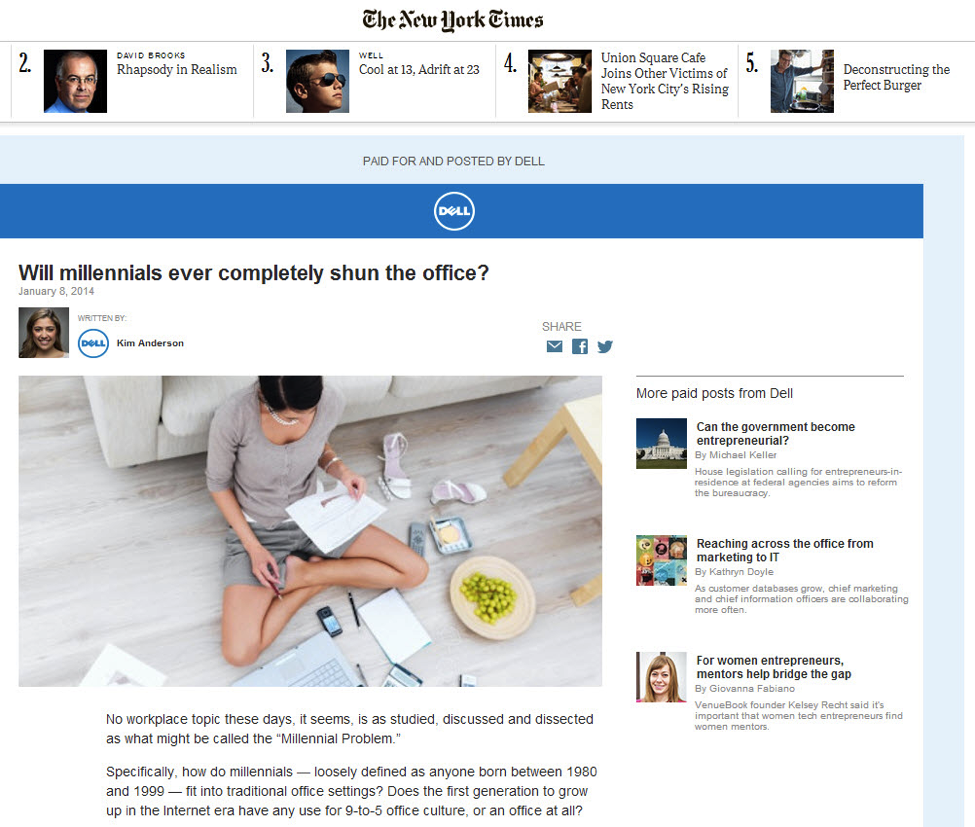For those who are unfamiliar, native advertising is a way to advertise your brand while blending in to the type of content that a website publishes. In other words, the advertisements don’t really look like ads—they just look like another piece of content. Of course because the whole idea is to blend in to a website, so this used to leave a lot of people feeling tricked or feeling as thought native advertising is unfair to consumers.
Fortunately, more and more people are warming up to the idea of native ads, but only if they’re done right. The examples below will help you understand how native ads work as well as show you how they can be done incorrectly.
A Few Great Examples of Native Advertising
Honda HR-V Crossover on Buzzfeed
Buzzfeed is the master of native advertising. They always make it very obvious that something is a sponsored ad or published by a “brand publisher,” so they are the perfect example of native advertising done right. The post isn’t necessarily about the brand, but it is somewhat related and fits in with the Buzzfeed style. As you can see, the article has nothing to do with the brand. Head over to Buzzfeed and you’ll find tons of examples!
IBM Smarter Planet with Forbes BrandVoice
Forbes has actually created a brand called “BrandVoice” that is full of sponsored content. The company logo will be at the top of the page showing that you are reading a native ad. The content in the above example is clearly not about their brand or a service to help you do something, but it instead talks about a general topic that Forbes readers may be interested in learning more about. The content is relevant and targeted and not promotional, so it’s the perfect native ad. I found the Forbes BrandVoice page thanks to a ClearVoice article, which I highly recommend checking out for even more in-depth information on native advertising.
What These Native Ads Did Right:
- They told us up-front that this was a native or sponsored ad.
- The content is interesting and follows the format of the publisher.
- The goal was to improve brand awareness and recognition, not sell a product.
- There is real value being provided to the reader.
A Few Not-So-Great Examples
The Atlantic
This is one of the most widely cited examples when it comes to bad native advertising. Based on the subject matter, it seems clear that The Atlantic probably earned some money for publishing this article. It wasn’t something The Atlantic would normally publish, and the publication ended up being mocked in the media by readers and other websites because it was so off target.
The New York Times
To be fair, The New York Times actually can be a great place to find examples of good native ads (see here), but this particular ad was a huge failure. As you can see, it’s obvious that the article was going to be about millennials in the workplace and Dell computers are a great option when working from home. I found this particular example in a Wordstream article, and they said it best, “the ‘Millennial work ethic angle is so tired it’s practically comatose. Even the question posed by the article is ridiculous—no, Millennials will not ‘shun’ offices, because most of them are saddled with back-breaking student loan debt and can’t find work.”
What These Native Ads Did Wrong:
- They were way too promotional.
- The content may have fit the mold of the website, but it was still boring and did not urge readers to engage or keep them entertained.
- The content wasn’t always advertised as being sponsored content or the warning was in small print, which can make it seem like the publication is trying to trick their audience.
Of course, there are lots of native advertising examples out there beyond just these six websites. Visit here to see a few more examples. I also highly recommend checking out the following John Oliver video that discusses the good and the bad of native advertising:
So what does native advertising have to do with SEO?
By now you may have realized that SEO can bleed into almost anything involving online advertising and marketing. While native advertising does fall more onto the paid online side of things, it can be great for SEO because it’s more sharable and more linkable. Both of these factors will help you earn betting rankings and help get your company visibility in the SERPs. In other words, because native ads are more fun, you can expect to see a lot of natural engagement happening, plain and simple.
MarketingLand published a great article here that discusses the importance of citations over links thanks to Google’s latest Penguin updates. When it comes to local SEO citations have always been important, and a citation doesn’t need a link; it’s a reference. Good SEO has always been about content, and we’re moving closer and closer to this basic idea, and native advertising is a huge part of that. The article states:
“As media companies rush to jump on the native advertising bandwagon, search marketers have a golden opportunity to help our customers behave like brands. If brand and the appearance of brand-ness is what Google values, how better to demonstrate that than with native advertising content distributed on authoritative sites that looks like editorial?”
Have you ever dabbled in native advertising? Whether you’re a brand or a consumer, let us know what you think of native advertising in the comment section below. Is it tricking readers? Will it help improve CTR and shares? We’d love to hear your thoughts!




